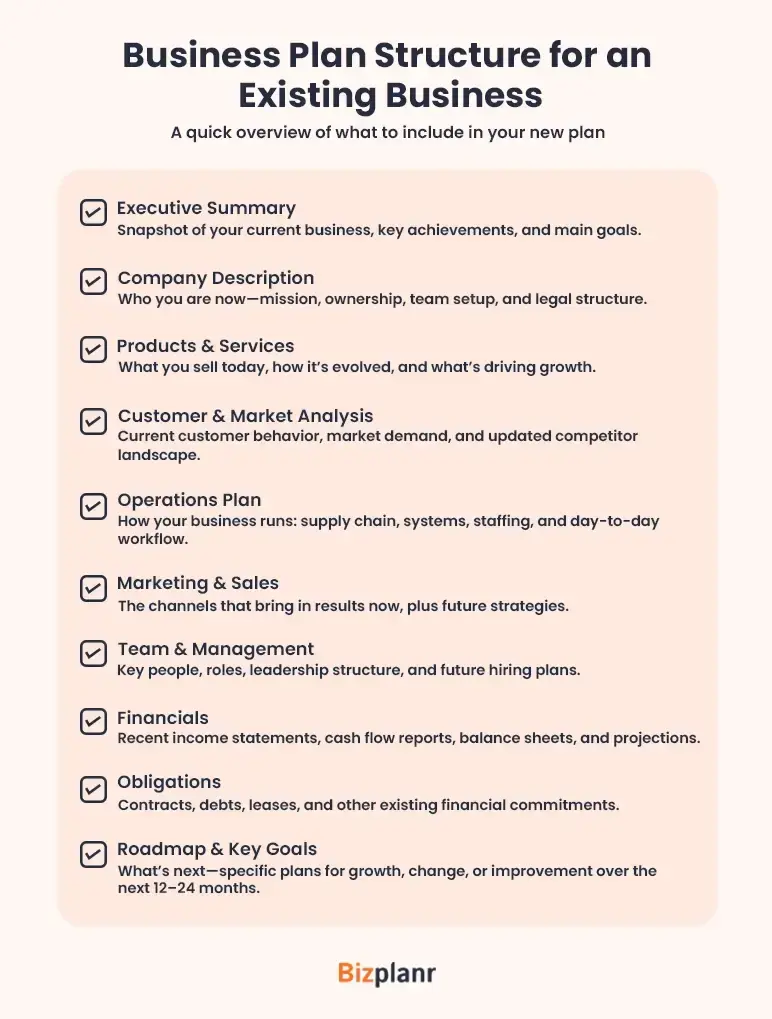Your business has changed.
Maybe you’ve grown, hit new milestones, or shifted directions. But if your business plan hasn’t kept up, it’s not doing its rightful job.
There, I said it.
If you're still running on the same plan you made back when you were figuring things out, we need to talk. That old plan probably doesn’t match your actual numbers, your team, or what you’re aiming for now.
And yes, that’s a problem, especially if you’re trying to secure an investment or planning your next move for your company.
This blog walks you through how to update your business plan for an existing business without starting from scratch. Smarter decisions start with an updated current plan. Let’s get into it.
When and why do businesses need a fresh plan?
At some point, every company hits a wall. What used to work...just doesn’t anymore. Maybe growth has slowed. Maybe revenue looks solid, but cash flow’s all over the place. Or you’re trying to scale, and the old business plan doesn’t reflect where you’re going.
And the business plan you had starts feeling like something you have to work around, not with.
So, when should you hit refresh?
If you're expanding. New locations? New product lines? Your structure, supply chain, and marketing all shift. And that needs to show up in your plan.
If ownership is changing. Selling your existing business or stepping into someone else’s company? A fresh plan clears up confusion and makes the handoff smoother.
If subtle things start slipping. Ads don’t hit like they used to. Costs quietly creep up. Retention drops. These are all signs your customer or business model has changed. Don’t wait until it gets worse.
If you’re stepping into a company that someone else built, you’re inheriting gaps. Writing a business plan for buying an existing business helps make sure you're not guessing your way through the handoff. It clarifies what needs to change and where the opportunity really is.
You don’t need to start from scratch. You just need a plan that reflects today, not year one. A plan that fits your company as it is now, and where it’s heading next.
What to do before you start writing?
Before you update your business plan for an existing business, it’s worth doing a full reset. Not everything from the last plan will apply today.
Start with your numbers. Review your cash flow statement, income statements, and balance sheets. Focus on what’s changed, like whether margins have improved or expenses are creeping up. A plan that’s based on outdated numbers won’t help with decisions.
Next, revisit your target market. Customer behavior shifts over time. Your original market analysis may no longer reflect who’s buying from you now or why.
Then look inward. Has your management framework changed? New hires, shifting roles, or leadership changes should show on your plan.
Finally, think through your business’s goals. Be specific. Are you trying to grow into new regions, reduce churn, or improve profit margins? General ambitions won’t give your plan direction.
Doing this prep work gives you clarity before you even write a business plan, so you’re setting direction based on what your business actually needs now.
How to write a business plan for an existing business (from scratch)
Writing a business plan for an existing business is different from planning a startup. You already have real customers, revenue, and operations, so your plan should reflect that.
Whether you're seeking investment, planning to grow, or just need clarity, here's what a full business plan should cover:
1) Executive summary
Summarize your business as it operates today. Highlight important achievements, current goals (like raising funds or entering new areas), and what this plan aims to support. Keep it short but meaningful. This sets the tone.
2) Company description
This section explains who you are now. Include your company’s mission, ownership structure, team setup, and how your operations have changed since the business started. If you've pivoted, grown, or expanded, this is where to include that information.
3) Products or services
Detail your current offerings. Focus on what you’re selling now, how those products or services solve problems of customers, and how they’re positioned. You can also explain changes over time and what drove those shifts.
4) Customer and competitive analysis
Use updated data to show who your customers are and how the industry looks today. What does the demand among the customers look like? Who are your competitors now? This section should show that you understand your space and where you're positioned within it.
The social app 222, designed to facilitate real-life meetings through personality quizzes, raised $2.5 million in seed funding. The company’s pitch deck effectively communicated the app's unique approach to social networking and its potential to disrupt traditional dating platforms.
This highlights the significance of a unique value proposition and the ability to convey how your product stands out in a market saturated with customers.
5) Operations plan
Explain how your business runs and its everyday efficiency. Include supply chain, tools, internal systems, staffing, and vendor relationships. If your operations are scaling, add how you plan to support that without breaking anything.
6) Marketing and sales strategy
Focus on the channels that actually bring in customers. List what you’re doing now, like online and offline ads, email, SEO, events, partnerships and how that’s working. Then explain any new strategies you’re adding and why.
7) Team and management structure
List down your management like your team members, what they handle, and how leadership is organized. If your plan includes hiring or shifting responsibilities, explain what that looks like and how it supports your business goals.
8) Financial projections and statements
Provide current income statements, cash flow reports, and balance sheets. Then add projections that reflect today’s performance. Tie financial projections to your goals like new hires, product development, expansion to show how the money will work and impact your financial health.
9) Legal and financial obligations
Include any contracts, leases, debts, or investor agreements that could impact cash flow or future planning. This section helps lenders and investors see the full financial picture, not just projections.
10) Roadmap and key goals
Wrap with a forward-looking plan: What are you focusing on in the next 12–24 months? Be specific. Whether it’s launching new products, expanding to new markets, or increasing margins, this part should show you’ve got a clear path ahead.
Your roadmap doesn’t need to predict the next five years. Just lay out your real priorities for the next year or two, whether it’s growth, expansion, or tightening your operations.
If you need proof that clarity matters more than length, just look at Airbnb’s original pitch deck. It was only 10 slides, but it outlined what’s important, and it worked. Your updated business plan doesn’t need to be long, just accurate and focused.
A step-by-step update like this brings your business plan back in line with your current goals and operations. Still, many businesses lose value by repeating avoidable issues, especially the kind of business plan mistakes that seem small but add up quickly.
Mistakes to avoid when updating a business plan
If you're going to invest the time in updating it, make sure you're not repeating these mistakes that many existing businesses fall into.
1) Goals and decisions don’t match
You might be making day-to-day choices based on new realities, but your plan is still written around goals that don’t reflect those shifts. That disconnect creates confusion and can pull your team in the wrong direction.
2) Mixed signals for the employees
If the goals in your business plan don’t match what your employees are working on, it sends mixed signals. Updated goals help keep priorities clear and everyone moving in the same direction.
3) Stale goals hurt credibility
When someone reads your plan, especially a lender or partner, they’re trying to understand what you care about. If your goals are stale or irrelevant, it’s hard for them to take your strategy seriously.
4) You’ve grown but didn’t reset milestones
It’s great that your business has grown, but if your plan still lists early-stage milestones, it won’t help with what comes next. A strong plan pushes the business forward.
5) Strategy and goals don’t align
Sometimes, the updated parts of the plan, like financials or operations, reflect your current path, but the goals are still tied to outdated strategies. That mismatch weakens the whole plan.
Avoiding these slip-ups is a good start to ensure your company’s success in the long run. Now, let’s talk about what you can actively do to make your business plan work harder for your company.
What can you do to make your business plan better?
Once your business plan is updated, it still has room to get better—more usable, more focused, and more helpful in the real world. Here are a few tips to make it work harder for you:
1) Write like someone else has to run the business
If someone had to step in and run things using only what you’ve written, would they be able to? That’s the test of how clearly you write a business plan and whether it’s truly useful or just a formality.
2) Link every section to the action
Saying “grow revenue” is easy. Explaining how, who's responsible, and when makes it real. Tie every objective to something trackable so you’re measuring success, not just intentions.
3) Add real check-in points
Review your financial estimates, cash movements, and market analysis regularly. Monthly, quarterly—whatever fits your business. The point is to make sure the plan stays useful as things change.
4) Keep the fluff out
If a section says a lot without saying anything, cut it. Keep things straightforward: What’s working, what’s not, and what’s next.
5) Make it easy to update
Your business plan shouldn’t be a pain to revisit. Structuring it well from the start helps, and if you want to speed things up or stay organized, smart tools like Bizplanr’s AI business plan generator can give you a clean starting point while keeping full control in your hands, ideal if you want a framework without giving up ownership of the content.
6) Actually use it
Bring your plan into team check-ins, reviews, and day-to-day decisions. Use it to check if your strategy still aligns with how your customers buy, respond, and engage. The more it becomes part of how your small business operates, the more valuable it gets.
Build a plan that works for the business you run today
A business plan you wrote as a new business probably doesn’t reflect your company anymore. A good business plan changes when the business does. That includes updated goals, fresh financials, and a management setup that actually matches your day-to-day.
So, if you’re still dragging around that old business plan template, it’s time for a refresh, and if you’re building from scratch, you may just need a business plan that fits where your business is today. And if rewriting the whole thing sounds like a drag, tools like Bizplanr can help speed things up.
Get Your Business Plan Ready In Minutes
Answer a few questions, and AI will generate a detailed business plan.
Frequently Asked Questions
What are the right times to update a business plan for an existing business?
An existing business should update its business plan anytime there’s a major change, like new goals, a shift in management, updated customer behavior, or financial changes. You don’t need a new plan every month, but you shouldn’t wait five years, either.
Do banks or investors care if it’s an “old” business plan?
Yes. They expect a business plan that reflects your current operations, not a version from when you were a new business.
Should an existing business plan include past performance data?
Absolutely. Your business plan should include past sales, costs, and trends to show how your existing business has performed.
Can you use the same business plan if you’re selling your business?
Not as-is. A sale needs a business plan that shows value to a new owner—updated customer data, financials, and clear management info. Repurposing a plan from your new business phase won’t cut it.







